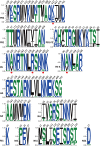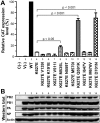Genomic Signatures for Avian H7N9 Viruses Adapting to Humans
- PMID: 26845764
- PMCID: PMC4742285
- DOI: 10.1371/journal.pone.0148432
Genomic Signatures for Avian H7N9 Viruses Adapting to Humans
Abstract
An avian influenza A H7N9 virus emerged in March 2013 and caused a remarkable number of human fatalities. Genome variability in these viruses may provide insights into host adaptability. We scanned over 140 genomes of the H7N9 viruses isolated from humans and identified 104 positions that exhibited seven or more amino acid substitutions. Approximately half of these substitutions were identified in the influenza ribonucleoprotein (RNP) complex. Although PB2 627K of the avian virus promotes replication in humans, 45 of the 147 investigated PB2 sequences retained the E signature at this position, which is an avian characteristic. We discovered 10 PB2 substitutions that covaried with K627E. An RNP activity assay showed that Q591K, D701N, and M535L restored the polymerase activity in human cells when 627K transformed to an avian-like E. Genomic analysis of the human-isolated avian influenza virus is crucial in assessing genome variability, because relationships between position-specific variations can be observed and explored. In this study, we observed alternative positions that can potentially compensate for PB2 627K, a well-known marker for cross-species infection. An RNP assay suggested Q591K, D701N, and M535L as potential markers for an H7N9 virus capable of infecting humans.
Conflict of interest statement
Figures



Similar articles
-
Amino acid substitutions in polymerase basic protein 2 gene contribute to the pathogenicity of the novel A/H7N9 influenza virus in mammalian hosts.J Virol. 2014 Mar;88(6):3568-76. doi: 10.1128/JVI.02740-13. Epub 2014 Jan 8. J Virol. 2014. PMID: 24403592 Free PMC article.
-
Multiple Natural Substitutions in Avian Influenza A Virus PB2 Facilitate Efficient Replication in Human Cells.J Virol. 2016 Jun 10;90(13):5928-5938. doi: 10.1128/JVI.00130-16. Print 2016 Jul 1. J Virol. 2016. PMID: 27076644 Free PMC article.
-
Evaluation of the human adaptation of influenza A/H7N9 virus in PB2 protein using human and swine respiratory tract explant cultures.Sci Rep. 2016 Oct 14;6:35401. doi: 10.1038/srep35401. Sci Rep. 2016. PMID: 27739468 Free PMC article.
-
Adaptive mutations in the H5N1 polymerase complex.Virus Res. 2013 Dec 5;178(1):53-62. doi: 10.1016/j.virusres.2013.05.010. Epub 2013 Jun 1. Virus Res. 2013. PMID: 23732876 Review.
-
Novel human H7N9 influenza virus in China.Integr Zool. 2014 Jun;9(3):372-5. doi: 10.1111/1749-4877.12047. Integr Zool. 2014. PMID: 24952971 Review.
Cited by
-
A pilot study on primary cultures of human respiratory tract epithelial cells to predict patients' responses to H7N9 infection.Oncotarget. 2018 Feb 20;9(18):14492-14508. doi: 10.18632/oncotarget.24537. eCollection 2018 Mar 6. Oncotarget. 2018. PMID: 29581859 Free PMC article.
-
The 1918 influenza pandemic: 100 years of questions answered and unanswered.Sci Transl Med. 2019 Jul 24;11(502):eaau5485. doi: 10.1126/scitranslmed.aau5485. Sci Transl Med. 2019. PMID: 31341062 Free PMC article. Review.
-
Antigenic Characterization of Neuraminidase of Influenza A/H7N9 Viruses Isolated in Different Years.Pharmaceuticals (Basel). 2022 Sep 9;15(9):1127. doi: 10.3390/ph15091127. Pharmaceuticals (Basel). 2022. PMID: 36145348 Free PMC article.
-
Mutual information networks reveal evolutionary relationships within the influenza A virus polymerase.bioRxiv [Preprint]. 2023 Feb 17:2023.02.16.528850. doi: 10.1101/2023.02.16.528850. bioRxiv. 2023. Update in: Virus Evol. 2023 May 27;9(1):vead037. doi: 10.1093/ve/vead037. PMID: 36824962 Free PMC article. Updated. Preprint.
-
Enhanced Immune Responses Conferring Cross-Protection by Skin Vaccination With a Tri-Component Influenza Vaccine Using a Microneedle Patch.Front Immunol. 2018 Jul 30;9:1705. doi: 10.3389/fimmu.2018.01705. eCollection 2018. Front Immunol. 2018. PMID: 30105019 Free PMC article.
References
-
- Lo YC, Chen WC, Huang WT, Lin YC, Liu MC, Kuo HW, et al. Surveillance of avian influenza A(H7N9) virus infection in humans and detection of the first imported human case in Taiwan, 3 April to 10 May 2013. Euro Surveill. 2013;18(20). Epub 2013/06/04. . - PubMed
-
- Taiwan Centers for Disease Control Press Releases– 02 January 2014 (https://www.cdc.gov.tw/english/info.aspx?treeid=bc2d4e89b154059b&nowtree...).
-
- Taiwan Centers for Disease Control Press Releases– 24 April 2014 (https://www.cdc.gov.tw/english/info.aspx?treeid=bc2d4e89b154059b&nowtree...).
-
- Taiwan Centers for Disease Control Press Releases– 26 April 2014 (https://www.cdc.gov.tw/english/info.aspx?treeid=bc2d4e89b154059b&nowtree...).
Publication types
MeSH terms
Substances
LinkOut - more resources
Full Text Sources
Other Literature Sources
Medical

